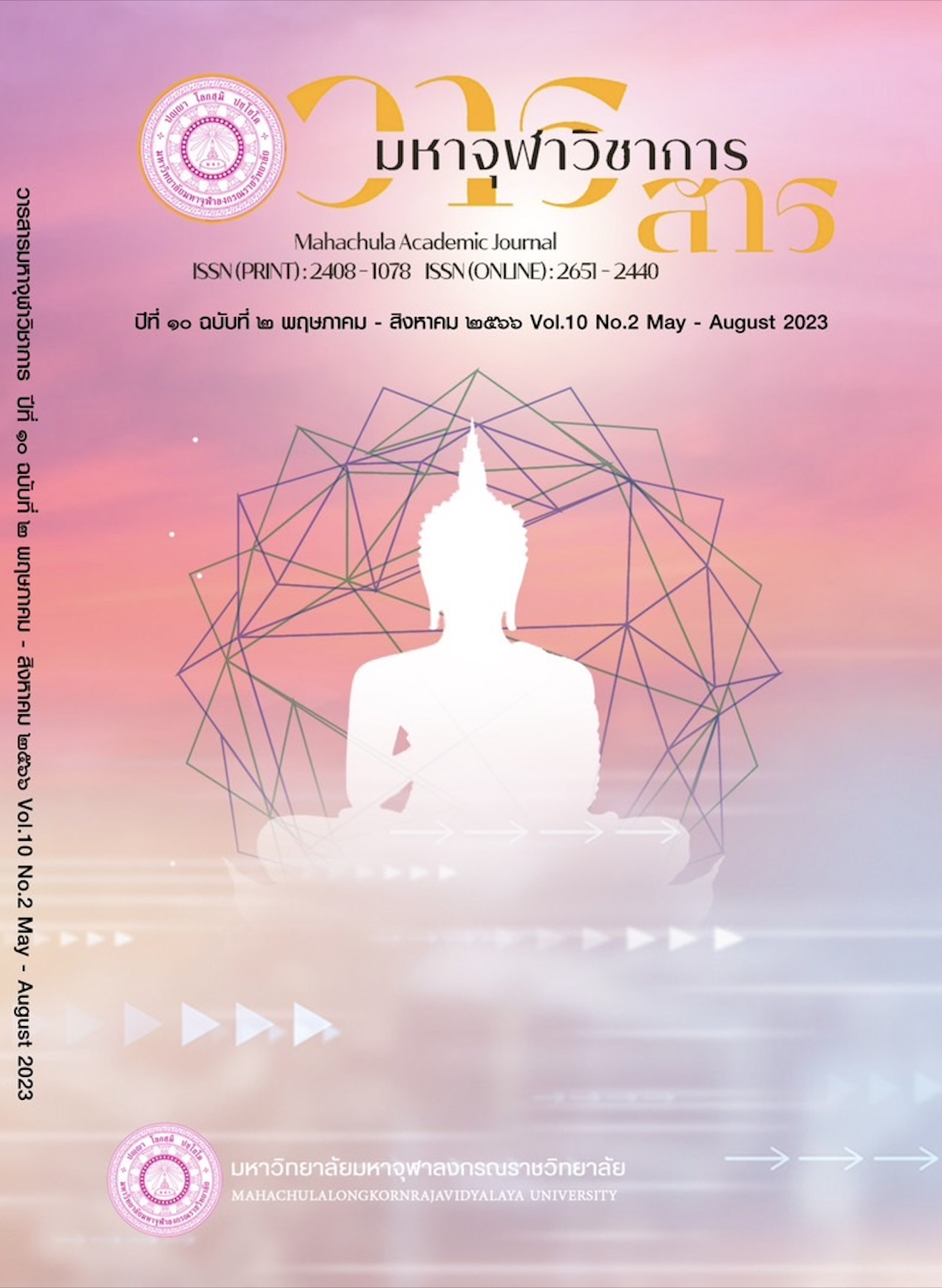A Study on the Courses of Existence of Cakkavattirāja as Appeared in Fine Arts of Rattanakosin Period
Main Article Content
Abstract
A study on the courses of existence of Cakkavattirāja as appeared in Fine Arts of Rattanakosin Period has three objectives: (1) to study the courses of existence of Cakkavattirāja in Tipiṭaka and its development in the Commentaries, Mahāyana Buddhist scriptures and later Pali literatures, (2) to study the origin, concept and the courses of existence of Cakkavattirāja made use by leaders in the periods of Kings Rāma the I-V, and (3) to study the courses of existence of Cakkavattirāja as appeared in various Fine Arts in the periods of Kings Rāma the I-V. This research employed the documentary research methodology.
The research results clearly showed that the courses of existence of Cakkavattirāja appeared since appeared before the emergence of Buddhism.The aristocrats’s ritual are Rajsuya and Vajabeiya in order to become Cakkavattirāja which basically means a person who cycle Cakka, that is power, pervading over through such given power In Buddhism, Cakkavattirāja offered Cakka, the power, where it pervades over through his virtues. In addition, Cakkavattirāja possesses a specialty, seven majestic gems of Cakkavattirāja and power which is beyond human abilities that ruled over four universal continents. Later on, on the one hand, in Mahayana Buddhism, there are many archetypal hierarchical of Cakkavattirājas, on the other hand, in Theravada Buddhism there is a similarity in categorizing the Cakkavattirāja s to different archetypal hierarchical since the discovery of Dĩpavaṁsa scripture. The kings and the aristocrats who believed in Lankāvaṁsa Buddhism were in Sri Lanka, Sukhothai, Lana and Ayutthaya until Rattanakosin period. The mentioned countries have used the moral virtues followed by Cakkavattirāja through naming, behaviours, moral principles, literatures and especially in architectures and fine arts. When it comes to the fine arts during the Rattanakosin period, since the King Rãma I - V, it discovered the Cakkavattirāja concept in Crowned Buddhas images that refer to Bodhisattva kings and Dhamikarajā kings. Moreover, the Crowned Buddhas images also refer to Mahājambupati sutta. The paintings on the wall appeared to demonstrate the reference from the Mahājambupati sutta. The paintings under the theme of seven majestic gems of Cakkavattirāja s also found Mahāsudassana sutta, Mandhātujātaka, Kāliṁkabodhijātaka etc. The discovering of the fine arts regarding Cakkavattirāja s had been mostly found during the period of King Rāma III. In the period of King Rāma IV, the popularity had declined. Until the period of King Rāma IV the attention given to the fine arts were no longer available and disappeared in the period of King Rāma V.
Article Details

This work is licensed under a Creative Commons Attribution-NonCommercial-NoDerivatives 4.0 International License.
References
กรมศิลปากร. วรรณกรรมสมัยอยุธยา เล่มที่ ๑. กรุงเทพมหานคร: กรมศิลปากร, ๒๕๔๕.
คณะกรรมการกองตำรา มหามกุฏราชวิทยาลัย. มงฺคลตฺถทีปนี (ปฐโม ภาโค). พิมพ์ครั้งที่ ๑๘. กรุงเทพมหานคร: มหามกุฏราชวิทยาลัย, ๒๕๖๐.
คณะสงฆ์หนเหนือ. ปัญญาสชาดก เล่ม ๑. พิมพ์ครั้งที่ ๓. กรุงเทพมหานคร: อาทรการพิมพ์, ๒๕๕๒.
เจ้าพระยาทิพากรวงศมหาโกษาธิบดี (ขำ บุนนาค). พระราชพงศาวดารกรุงรัตนโกสินทร์ รัชกาลที่ ๑ ฉบับเจ้าพระยาทิพากรวงศมหาโกษาธิบดี. กรุงเทพมหานคร: คณะสงฆ์วัดพระเชตุพนวิมลมังคลาราม และมูลนิธิ “ทุนพระพุทธยอดฟ้า”, ๒๕๕๒.
ชาตรี ประกิตนนทการ. การเมืองในสถาปัตยกรรมสมัยรัชกาลที่ ๑. กรุงเทพมหานคร: มติชน, ๒๕๕๘.
ธนโชติ เกียรติณภัทร. วรรณคดีสุโขทัย. กรุงเทพมหานคร: มหาวิทยาลัยรามคำแหง, ๒๕๖๔.
ธนภัทร์ ลิ้มหัสนัยกุล. “ชมพูบดีสูตรในจิตรกรรมฝาผนังช่วงพุทธศตวรรษที่ ๒๔-๒๕”. วิทยานิพนธ์ศิลปศาสตร์มหาบัณฑิต
สาขาวิชาประวัติศาสตร์ศิลปะ. บัณฑิตวิทยาลัย: มหาวิทยาลัยศิลปากร, ๒๕๕๘.
นิยะดา เหล่าสุนทร. ท้าวมหาชมพู ต้นตำนานพระพุทธรูปทรงเครื่อง. นนทบุรี: สำนักพิมพ์มหาวิทยาลัยสุโขทัยธรรมาธิราช, ๒๕๕๓.
พระเจ้าบรมวงษ์เธอ กรมพระดำรงราชานุภาพฯ. เรื่องประดิษฐานพระสงฆ์สยามวงษ์ในลังกาทวีป. กรุงเทพมหานคร: กรมแผนที่ทหาร, ๒๔๕๙.
พระญาลิไทย. เตภูมิกถา. นนทบุรี: โรงพิมพ์ศรีปัญญา, ๒๕๖๔.
พระสังฆราชเมธังกร. โลกทีปกสาร. แปลโดย แย้ม ประพัฒน์ทอง. พิมพ์ครั้งที่ ๒. กรุงเทพมหานคร: หอสมุดแห่งชาติ กรมศิลปากร, ๒๕๔๙.
พระสัทธรรมโฆษเถระ. โลกบัญญัตติ. แปลโดย แย้ม ประพัฒน์ทอง. กรุงเทพมหานคร: หอสมุดแห่งชาติ กรมศิลปากร, ๒๕๒๘.
พิชญา สุ่มจินดา. ถอดรหัสพระจอมเกล้า. กรุงเทพมหานคร: มติชน, ๒๕๕๗.
มหาจุฬาลงกรณราชวิทยาลัย. พระไตรปิฎกภาษาบาลี ฉบับมหาจุฬาเตปิฏกํ ๒๕๐๐. กรุงเทพมหานคร: โรงพิมพ์มหาจุฬาลงกรณราชวิทยาลัย, ๒๕๐๐-๒๕๓๒.
มหาจุฬาลงกรณราชวิทยาลัย. อรรถกถาภาษาบาลี ฉบับมหาจุฬาอฏฺฐกถา. กรุงเทพมหานคร: โรงพิมพ์มหาจุฬาลงกรณราชวิทยาลัย, ๒๕๓๒-๒๕๓๔.
ไมเคิล ไรท์. “พระอินทร์”. ศิลปวัฒนธรรม. ปีที่ ๒๕ ฉบับ ๑๐ (สิงหาคม ๒๕๔๗) : ๑๕๕-๑๕๙.
รุ่งโรจน์ ภิรมย์อนุกูล, ธนกฤต ลออสุวรรณ, และธนโชติ เกียรติณภัทร. สมโภชสองศตวรรษ วัดไพชยนต์พลเสพย์ราชวรวิหาร : จิตรกรรมฝาผนัง. นครปฐม: รุ่งศิลป์การพิมพ์ (๑๙๗๗), ๒๕๖๓.
รุ่งโรจน์ ภิรมย์อนุกูล. “จักรพรรดิ: ราชาเหนือราชาในอุดมคติ”. เมืองโบราณ. ปีที่ ๓๘ ฉบับที่ ๑ (มกราคม – มีนาคม ๒๕๕๕) : ๘๓-๙๒.
วรพร ภู่พงศ์พันธุ์. สถาบันกษัตริย์ในกฎมณเทียรบาล. พิมพ์ครั้งที่ ๒. กรุงเทพมหานคร: แสงดาว, ๒๕๖๔.
สมเด็จพระเจ้าบรมวงศ์เธอ กรมพระยาดำรงราชานุภาพ. พระราชพงศาวดาร ฉบับพระราชหัตถเลขา. พิมพ์ครั้งที่ ๑๐. นนทบุรี: ศรีปัญญา, ๒๕๖๔.
สุจิตต์ วงษ์เทศ. บางขุนเทียน ส่วนหนึ่ของแผ่นดินไทยและ กรุงรัตนโกสินทร์. กรุงเทพมหานคร: โรงพิมพ์คเณศ, ๒๕๓๐.
สุลักษณ์ ศิวรักษ์. ความเข้าใจในเรื่องพระเจ้าอโศกและอโศกาวทาน. พิมพ์ครั้งที่ ๓. กรุงเทพมหานคร: ศูนย์ไทยธิเบต, ๒๕๔๗.
เอนก มากอนันต์. จักรพรรดิราช คติอำนาจเบื้องหลังชนชั้นนำไทย. พิมพ์ครั้งที่ ๒. กรุงเทพมหานคร: สำนักพิมพ์มติชน, ๒๕๖๒.
Hermann Oldenberg. The Dipavamsa An Ancient Buddhist Historical Record. London: Williams and Norgate, 1979.
Vasubandhu. Abidharmakosabhasya 2. [translated] by Louis de La Valine Poussin; English translation by Leo M. Pruden. — Berkeley. Calif.: Asian Humanities Press, 1988-1990.


